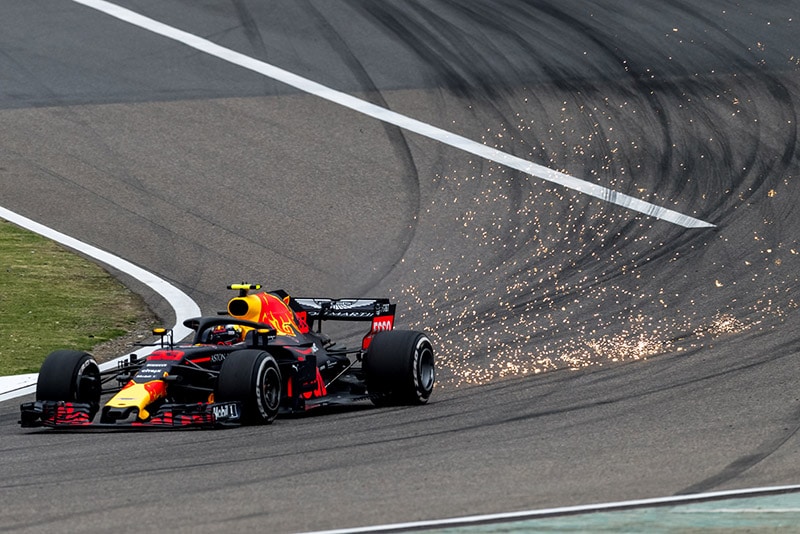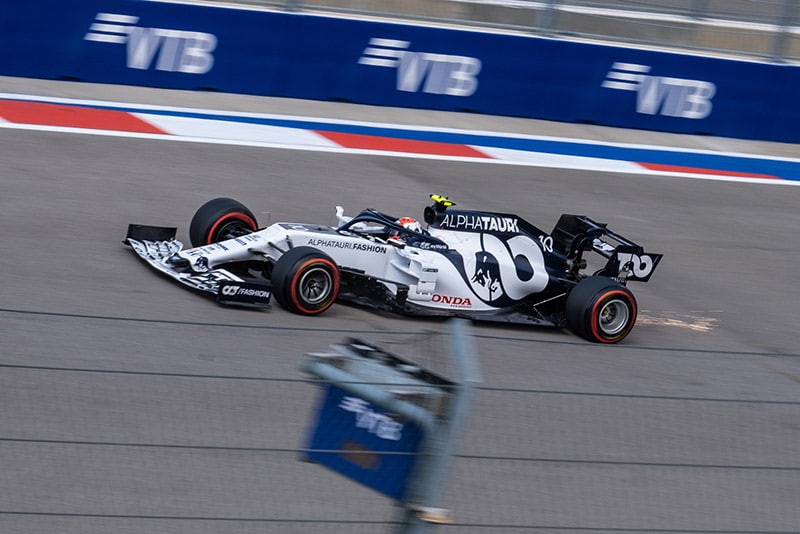If you’ve ever watched a Formula 1 race, then you’ve likely noticed that the cars in this motorsport spark quite a lot.
And if you didn’t know any better, then you might find the sparking a bit alarming.
But not to worry, there is a completely logical reasons that Formula 1 cars spark so much.
On the underside of F1 cars is a wooden plank that is embedded with titanium skid blocks and when that titanium makes contact with the racetrack surface it creates those infamous sparks you see during the circuit races.
Keep reading to learn more about the sparking you see from Formula 1 race cars.
Reason Formula 1 Cars Spark So Much

Normally when you see sparks coming from the undercarriage of a car, that means something is wrong – but this is not true for F1 cars.
In order to prevent the race cars from bottoming out when on the straights, and to improve the underbody aerodynamics of the car, all F1 cars have this wooden plank on the underside that stretches all the way from the back of the car until it almost reaches the front wheels.
This wooden plank is made out of a material known as Jabroc and it has these titanium skid blocks throughout the plank.
You never see this plank during a race because it is designed to never protrude out from the car more than 3mm.
Due to the low-sitting design of Formula One cars, these planks are necessary to prevent the vehicle from bottoming out.
But as a result, the plank makes contact with the road surface, and those titanium skid blocks react to that contact by sparking.
You’ll notice that aerodynamics results in more sparks when the F1 car is pushed more towards the ground, and fewer sparks when the opposite occurs.
What’s interesting is that these titanium embedded wood planks were not made mandatory until 2015, even though sparks first started appearing in races during the 1980s.
And you gotta admit – the sparks flying from the back of F1 cars look pretty cool, especially at night.
Why Formula 1 Cars Use Titanium Skid Blocks
While we already covered above that the first time spectators saw the now iconic sparks flying from the rear of F1 cars was in the 1980s, there is some interesting history here.
As you may know, there were some safety concerns with the materials the race teams were embedding in the wooden planks, as well as the thickness of those planks.
They didn’t want drivers to run their cars too low to the ground, and they didn’t want them creating unsafe situations for other drivers.
It might surprise you to know that up until 2015 the standard was actually Kevlar and not titanium.
So, in 2015 the official rules and regulations were changed to made titanium mandatory because it is both safer and wear down faster.
Plus, it ends up creating way more sparks, which is awesome for spectators.

Do The F1 Car Sparks Damage The Cars?
Though your brain likely associates sparking cars with damage, that couldn’t be further from the truth for F1 cars.
So no, the sparks do not damage the Formula 1 cars.
In fact, it’s just the opposite because it means that the wooden plank is doing its job and protecting the undercarriage of the race car from bottoming out and causing real damage.
Why Do F1 Cars Spark More On The Straights?
If you’ve watched any Formula 1 races, then you’ve likely noticed that F1 cars tend to do a lot more sparking when on the straights.
Ever wonder why that is?
F1 cars spark more on the straights because the downforce from the race car going faster, and that higher speed the cars can reach on the straights compared to corners, means that it is sitting lower to the ground.
And when it sits lower to the ground, there is more chance of contact with those titanium skid blocks and greater chance of sparking.
When F1 cars corner, they do so at a lower speed, which means less downforce and that results in the race car sitting higher up from the ground – so less chance of contact with the wooden plank on the underside.

Why Are F1 Cars So Low To The Ground?
It’s all about aerodynamics and gravity – so, basically it is entirely by design.
Formula 1 cars are able to achieve such incredibly fast lap times due to the lower center of gravity of the cars.
It’s really just science.
If you want more downforce when moving at high speeds, then you need a car that is very low to the ground.
Why Do F1 Cars Spark More At Night?
Spoiler alert: F1 cars do not spark more at night.
It just seems like the Formula 1 cars spark more at night because the lack of sunlight makes the sparks more noticeable to you.
Honestly, I prefer watching the night races because the sparking looks so much better since we can really see all of it lighting up the circuit.
Where Do F1 Cars Spark The Most?
As previously mentioned, F1 cars spark the most on the straights because the higher speeds the cars achieve on the straights means more downforce.
Tracks that have elevation changes also tend to result in more sparking from the F1 cars. This includes:
- Spa-Francorchamps
- Suzuka
- Spielberg Circuit (Austria)
- Monaco
- Imola
- Zandvoort
- Sao Paulo
- Austin

The circuits that tend to have the night races, where the sparks are most visible are:
- Abu Dhabi
- Jeddah
- Sakhir
- Singapore
Circuits that have a lot of bumps in the street also tend to result in a lot of sparks. This includes:
- Monaco
- Montreal
- Melbourne
- Baku
- Singapore
Will 2022 F1 Car Aerodynamic Changes Result In Fewer Sparks?
As you may know, there have been some aerodynamic changes for the 2022 Formula 1 season that results in the F1 cars being quite different from previous seasons.
The flat floor changes are going to result in greater downforce.
With that in mind, it stand to reason that we will see more sparks from the F1 cars during the 2022 season.

Final Word
As you can see, there is a good reason for F1 cars sparking so much – its just science.
There is no need to be alarmed when you see the sparking, so just enjoy the spectacle as you watch the Formula 1 races at home.
And, expect to see even more sparks from Formula One cars starting with the 2022 season.
